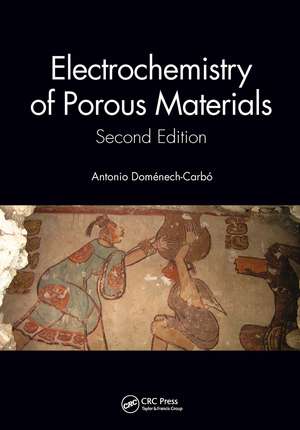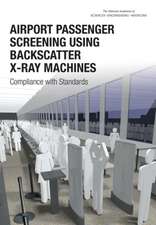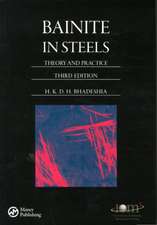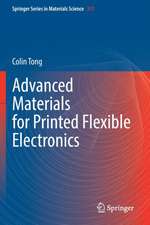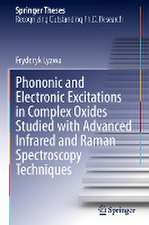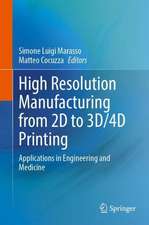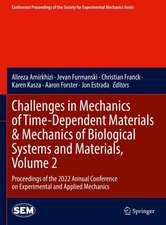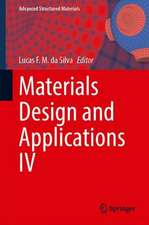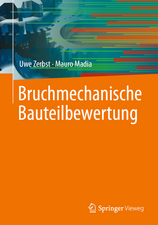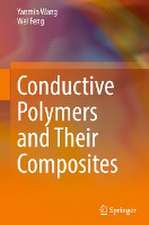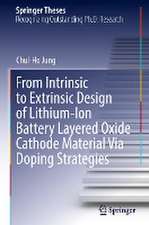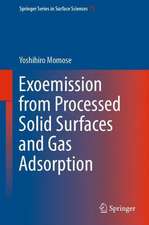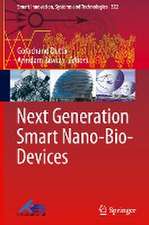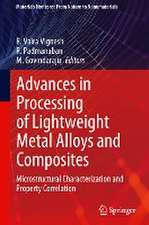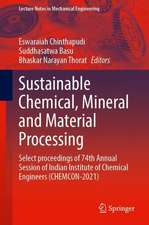Electrochemistry of Porous Materials
Autor Antonio Doménech Carbóen Limba Engleză Paperback – 21 feb 2023
Concentrating on nanostructured micro- and mesoporous materials, the highly anticipated Second Edition offers a more focused and practical analysis of key porous materials considered relatively homogeneous from an electrochemical point of view. The author details the use of electrochemical methods in materials science for characterization and their applications in the fields of analysis, energy production and storage, environmental remediation, and the biomedical arena.
Additional features include:
- Incorporates new theoretical advances in the voltammetry of porous materials and multiphase porous electrochemistry.
- Includes new developments in sensing, energy production and storage, degradation of pollutants, desalination and drug release.
- Describes redox processes for different porous materials, assessing their electrochemical applications.
- Written at an accessible and understandable level for researchers and graduate students working in the field of material chemistry.
Selective and streamlined, Electrochemistry of Porous Materials, Second Edition culls a wide range of relevant and practically useful material from the extensive literature on the subject, making it an invaluable reference for readers of all levels of understanding.
| Toate formatele și edițiile | Preț | Express |
|---|---|---|
| Paperback (1) | 416.22 lei 6-8 săpt. | |
| CRC Press – 21 feb 2023 | 416.22 lei 6-8 săpt. | |
| Hardback (1) | 1294.67 lei 6-8 săpt. | |
| CRC Press – 21 mai 2021 | 1294.67 lei 6-8 săpt. |
Preț: 416.22 lei
Nou
Puncte Express: 624
Preț estimativ în valută:
79.64€ • 83.15$ • 65.92£
79.64€ • 83.15$ • 65.92£
Carte tipărită la comandă
Livrare economică 04-18 aprilie
Preluare comenzi: 021 569.72.76
Specificații
ISBN-13: 9781032474267
ISBN-10: 1032474262
Pagini: 350
Ilustrații: 184
Dimensiuni: 178 x 254 mm
Greutate: 0.45 kg
Ediția:2
Editura: CRC Press
Colecția CRC Press
ISBN-10: 1032474262
Pagini: 350
Ilustrații: 184
Dimensiuni: 178 x 254 mm
Greutate: 0.45 kg
Ediția:2
Editura: CRC Press
Colecția CRC Press
Descriere
Provides essential theoretical aspects of the electrochemistry of nanostructured materials and the main fields of application, incorporating the advances in the field in the last ten years since publication of the first edition. These include recent theoretical formulations and the incorporation of novel materials
Cuprins
1. POROUS MATERIALS AND ELECTROCHEMISTRY.
1.1. Porous materials, concept and classifications.
1.2. Mixed porous materials.
1.3. Electrochemistry and porous materials.
1.4. Synthesis of porous materials.
1.5. Material-modified electrodes.
1.6. Electrode-modified materials.
1.7. General electrochemical considerations.
1.8. Diffusive aspects.
1.9. Voltammetry and related techniques.
1.10. Resistive and capacitive effects.
1.11. Electrochemical impedance spectroscopy.
1.12. Other techniques.
References.
2. ELECTROCHEMICAL PROCESSES AT POROUS ELECTRODES
2.1. Introduction.
2.2. Porous electrodes: impedance analysis.
2.3. Voltammetry at porous electrodes.
2.4. Confinement and diffusion in pores.
2.5. Insulating porous films.
2.6. Fractal surfaces.
2.7. The problem of the oxidation state.
2.8. Electrochemistry at nanopores.
References.
3. ELECTROCHEMICAL PROCESSES AT ION-PERMEABLE SOLIDS
3.1. Introduction.
3.2. General approach.
3.3. Insertion electrochemical electrodes.
3.4. Ion transport.
3.5. Mixed phases and miscibility gaps.
3.6. Microparticles electrochemistry.
3.7. Determination of electrochemical parameters of individual ions.
3.8. Refinements.
3.9. Overview.
References.
4. ELECTROCATALYSIS
4.1. Introduction.
4.2. Heterogeneous electrocatalysis.
4.3. Structural and electronic effects.
4.4. Electrocatalysis at microheterogeneous deposits of porous materials.
4.5. Electrocatalysis at ion-permeable solids.
4.6. Overview.
References.
5. ELECTROCHEMISTRY OF ALUMINOSILICATES
5.1. Introduction.
5.2. Electrochemistry of zeolite-associated species.
5.3. Topological redox isomers.
5.4. Species distribution.
5.5. Speciation: the Maya blue problem.
5.6. Electroactive structural species.
5.7. Mesoporous materials.
5.8. Final remarks.
References.
6. ELECTROCHEMISTRY OF METAL-ORGANIC FRAMEWORKS
6.1. Introduction.
6.2. MOF electrochemistry: an overview.
6.3. Electrochemistry of MOFs involving topotactic transformations.
6.4. Electrochemistry of MOFs involving metal deposition.
6.5. MOFs at the mesoscopic scale.
6.6. Applications.
References.
7. ELECTROCHEMISTRY OF POROUS METALS AND ANODIC METAL OXIDE FILMS
7.1. Introduction.
7.2. Electrochemistry of noble metals.
7.3. Electrocatalysis of noble metals.
7.4. Porous anodic metal oxide films.
7.5. Applications of porous metals and oxidic porous layers.
7.6. Impedance analysis of metal oxide layers.
7.7. Pseudocapacitive behavior.
References.
8. ELECTROCHEMISTRY OF POROUS OXIDES AND RELATED MATERIALS
8.1. Overview.
8.2. Electrochemistry of metal oxides and metal oxohydroxides.
8.3. Electrochemistry of layered hydroxides and related materials.
8.4. Electrochemistry of polyoxometalates.
8.5. Electrochemistry of doped materials.
8.6. Electrocatalysis.
8.7. Active surface phases.
References.
9. SULFIDES, NITRIDES, PHOSPHIDES
9.1. Introduction.
9.2. Molybdenum disulfide and related materials.
9.3. Boron nitride and related materials.
9.4. Metal phosphides.
9.5. Metal carbides.
9.6. Other materials.
References.
10. ELECTROCHEMISTRY OF POROUS CARBON-BASED MATERIALS
10.1. Carbons as electrochemical materials.
10.2. Carbon activation, functionalization and doping.
10.3. Porous carbons.
10.4. Carbon nanotubes and nanoribbons.
10.5. Graphene(s).
10.6. Fullerenes.
10.7. Direct electrochemical synthesis of carbon materials.
10.8. Applications.
10.9. Influence of impurities on carbon electrochemistry.
References.
11. ELECTROCHEMISTRY OF POROUS POLYMERS AND HYBRID MATERIALS
11.1. Introduction.
11.2. Conducting polymers.
11.3. Hybrid materials based on conducting polymers.
11.4. Composite materials based on conducting polymers.
11.5. Photoelectrochemistry.
11.6. Polymers of intrinsic microporosity.
11.7. Polymer electrolytes.
11.8. Final remarks.
References.
12. ELECTROCHEMICAL SENSING VIA POROUS MATERIALS
12.1. Electrochemical sensing.
12.2. Potentiometric sensing.
12.3. Voltammetric and amperometric sensing.
12.4. Selectivity.
12.5. Enantioselective electrochemical sensing.
12.6. Chemorresistive and impedimetric sensing.
12.7. Electrochemoluminiscence and photoelectrochemical sensing.
12.8. Biochemical sensing.
12.9. Electrochemical switch.
12.10. Perspectives.
References.
13. ELECTROCHEMICAL GAS SENSING
13.1. Gas sensing.
13.2. Chemiresistive sensors.
13.3. Impedance sensors.
13.4. Potentiometric sensors.
13.5. Amperometric sensors.
13.6. Field effect transistors.
13.7. Concluding remarks.
References.
14. SUPERCAPACITORS, BATTERIES, FUEL CELLS AND RELATED APPLICATIONS
10.1 Electrical energy storage and conversion.
10.2. Capacitors and supercapacitors.
10.3. Nickel batteries.
10.4. Lithium batteries.
10.5. Fuel cells.
10.6. Electrocgeneration.
15. MAGNETOELECTROCHEMISTRY AND PHOTOELECTROCHEMISTRY OF POROUS MATERIALS
15.1. Magnetoelectrochemistry.
15.2. Photoelectrochemistry.
15.3. Capacitive voltammetry of semiconductors.
15.4. Photon energy and redox processes
15.5. Photochemical water splitting.
15.6. Photoelectrocatalysts attached to porous solids.
15.7. Electrochromic materials and electrochemiluminiscence.
15.8. Dye-sensitized cells.
References.
16. MICROPOROUS MATERIALS IN ELECTROSYNTHESIS, ENVIRONMENTAL REMEDIATION AND DRUG RELEASE
16.1. Introduction.
16.2. Electrolytic synthesis involving porous electrodes.
16.3. Solid to solid synthesis.
16.4. Electrochemical degradation of contaminants.
16.5. Degradation/generation.
16.6. Photoelectrochemical degradation.
16.7. Desalination.
16.8. Drug delivery.
References.
Additional literature.
List of acronyms
1.1. Porous materials, concept and classifications.
1.2. Mixed porous materials.
1.3. Electrochemistry and porous materials.
1.4. Synthesis of porous materials.
1.5. Material-modified electrodes.
1.6. Electrode-modified materials.
1.7. General electrochemical considerations.
1.8. Diffusive aspects.
1.9. Voltammetry and related techniques.
1.10. Resistive and capacitive effects.
1.11. Electrochemical impedance spectroscopy.
1.12. Other techniques.
References.
2. ELECTROCHEMICAL PROCESSES AT POROUS ELECTRODES
2.1. Introduction.
2.2. Porous electrodes: impedance analysis.
2.3. Voltammetry at porous electrodes.
2.4. Confinement and diffusion in pores.
2.5. Insulating porous films.
2.6. Fractal surfaces.
2.7. The problem of the oxidation state.
2.8. Electrochemistry at nanopores.
References.
3. ELECTROCHEMICAL PROCESSES AT ION-PERMEABLE SOLIDS
3.1. Introduction.
3.2. General approach.
3.3. Insertion electrochemical electrodes.
3.4. Ion transport.
3.5. Mixed phases and miscibility gaps.
3.6. Microparticles electrochemistry.
3.7. Determination of electrochemical parameters of individual ions.
3.8. Refinements.
3.9. Overview.
References.
4. ELECTROCATALYSIS
4.1. Introduction.
4.2. Heterogeneous electrocatalysis.
4.3. Structural and electronic effects.
4.4. Electrocatalysis at microheterogeneous deposits of porous materials.
4.5. Electrocatalysis at ion-permeable solids.
4.6. Overview.
References.
5. ELECTROCHEMISTRY OF ALUMINOSILICATES
5.1. Introduction.
5.2. Electrochemistry of zeolite-associated species.
5.3. Topological redox isomers.
5.4. Species distribution.
5.5. Speciation: the Maya blue problem.
5.6. Electroactive structural species.
5.7. Mesoporous materials.
5.8. Final remarks.
References.
6. ELECTROCHEMISTRY OF METAL-ORGANIC FRAMEWORKS
6.1. Introduction.
6.2. MOF electrochemistry: an overview.
6.3. Electrochemistry of MOFs involving topotactic transformations.
6.4. Electrochemistry of MOFs involving metal deposition.
6.5. MOFs at the mesoscopic scale.
6.6. Applications.
References.
7. ELECTROCHEMISTRY OF POROUS METALS AND ANODIC METAL OXIDE FILMS
7.1. Introduction.
7.2. Electrochemistry of noble metals.
7.3. Electrocatalysis of noble metals.
7.4. Porous anodic metal oxide films.
7.5. Applications of porous metals and oxidic porous layers.
7.6. Impedance analysis of metal oxide layers.
7.7. Pseudocapacitive behavior.
References.
8. ELECTROCHEMISTRY OF POROUS OXIDES AND RELATED MATERIALS
8.1. Overview.
8.2. Electrochemistry of metal oxides and metal oxohydroxides.
8.3. Electrochemistry of layered hydroxides and related materials.
8.4. Electrochemistry of polyoxometalates.
8.5. Electrochemistry of doped materials.
8.6. Electrocatalysis.
8.7. Active surface phases.
References.
9. SULFIDES, NITRIDES, PHOSPHIDES
9.1. Introduction.
9.2. Molybdenum disulfide and related materials.
9.3. Boron nitride and related materials.
9.4. Metal phosphides.
9.5. Metal carbides.
9.6. Other materials.
References.
10. ELECTROCHEMISTRY OF POROUS CARBON-BASED MATERIALS
10.1. Carbons as electrochemical materials.
10.2. Carbon activation, functionalization and doping.
10.3. Porous carbons.
10.4. Carbon nanotubes and nanoribbons.
10.5. Graphene(s).
10.6. Fullerenes.
10.7. Direct electrochemical synthesis of carbon materials.
10.8. Applications.
10.9. Influence of impurities on carbon electrochemistry.
References.
11. ELECTROCHEMISTRY OF POROUS POLYMERS AND HYBRID MATERIALS
11.1. Introduction.
11.2. Conducting polymers.
11.3. Hybrid materials based on conducting polymers.
11.4. Composite materials based on conducting polymers.
11.5. Photoelectrochemistry.
11.6. Polymers of intrinsic microporosity.
11.7. Polymer electrolytes.
11.8. Final remarks.
References.
12. ELECTROCHEMICAL SENSING VIA POROUS MATERIALS
12.1. Electrochemical sensing.
12.2. Potentiometric sensing.
12.3. Voltammetric and amperometric sensing.
12.4. Selectivity.
12.5. Enantioselective electrochemical sensing.
12.6. Chemorresistive and impedimetric sensing.
12.7. Electrochemoluminiscence and photoelectrochemical sensing.
12.8. Biochemical sensing.
12.9. Electrochemical switch.
12.10. Perspectives.
References.
13. ELECTROCHEMICAL GAS SENSING
13.1. Gas sensing.
13.2. Chemiresistive sensors.
13.3. Impedance sensors.
13.4. Potentiometric sensors.
13.5. Amperometric sensors.
13.6. Field effect transistors.
13.7. Concluding remarks.
References.
14. SUPERCAPACITORS, BATTERIES, FUEL CELLS AND RELATED APPLICATIONS
10.1 Electrical energy storage and conversion.
10.2. Capacitors and supercapacitors.
10.3. Nickel batteries.
10.4. Lithium batteries.
10.5. Fuel cells.
10.6. Electrocgeneration.
15. MAGNETOELECTROCHEMISTRY AND PHOTOELECTROCHEMISTRY OF POROUS MATERIALS
15.1. Magnetoelectrochemistry.
15.2. Photoelectrochemistry.
15.3. Capacitive voltammetry of semiconductors.
15.4. Photon energy and redox processes
15.5. Photochemical water splitting.
15.6. Photoelectrocatalysts attached to porous solids.
15.7. Electrochromic materials and electrochemiluminiscence.
15.8. Dye-sensitized cells.
References.
16. MICROPOROUS MATERIALS IN ELECTROSYNTHESIS, ENVIRONMENTAL REMEDIATION AND DRUG RELEASE
16.1. Introduction.
16.2. Electrolytic synthesis involving porous electrodes.
16.3. Solid to solid synthesis.
16.4. Electrochemical degradation of contaminants.
16.5. Degradation/generation.
16.6. Photoelectrochemical degradation.
16.7. Desalination.
16.8. Drug delivery.
References.
Additional literature.
List of acronyms
